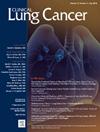Correlation Between the Extent of N1 Lymph Node Station Examination and Prognosis in Stage I Non-small Cell Lung Cancer Patients: One Station is Insufficient
IF 3.3
3区 医学
Q2 ONCOLOGY
引用次数: 0
Abstract
Background
Examination standards for hilar and intrapulmonary (N1) lymph nodes (LNs) have been debated. The objective of this study was to assess the prognostic significance of the extent of examination for N1 LN stations in patients with pathological stage I non-small cell lung cancer (NSCLC).
Methods
A total of 1868 patients were identified and divided into 3 groups on the basis of the number of N1 stations examined: group A (≥3 stations), group B (2 stations) and group C (1 station). Moreover, we investigated the prognostic significance of each individual N1 station examined. The primary outcome was 5-year disease-free survival (DFS).
Results
Overall, 1062, 607, and 199 patients were in groups A, B, and C, respectively. The baseline demographic and clinical characteristics were similar among the groups, except for the tumor side. The 5-year DFS rates were comparable between groups A and B (85.1% vs. 82.7%, P = .3), both of which were significantly greater than that of group C (74.4%) (P < .01). Similar results were observed for the corresponding 5-year overall survival rates. The number of N1 stations examined was an independent predictor in multiple analyses. Additionally, the examination of stations 10 and 13 were independent favorable predictors for 5-year DFS.
Conclusion
For patients with pathological stage I NSCLC, examination of only 1 N1 station is insufficient. Examinations of a minimum of two N1 stations, including stations 10 and 13, is recommended to obtain the optimal survival benefit.
非小细胞肺癌I期N1淋巴结站检查范围与预后的关系:单站检查不够
背景:肺门和肺内淋巴结(N1)的检查标准一直存在争议。本研究的目的是评估病理I期非小细胞肺癌(NSCLC)患者N1 LN站检查范围的预后意义。方法:共鉴定1868例患者,根据检查到的N1站数分为A组(≥3个)、B组(2个)和C组(1个)。此外,我们还调查了每个检测到的N1站的预后意义。主要终点为5年无病生存期(DFS)。结果:A、B、C组患者分别为1062例、607例和199例。除了肿瘤一侧外,各组的基线人口学和临床特征相似。A组与B组5年DFS比较,差异无统计学意义(85.1% vs. 82.7%, P = 0.3),均显著高于C组(74.4%)(P < 0.01)。相应的5年总生存率也观察到类似的结果。在多重分析中,N1站的数量是一个独立的预测因子。此外,10站和13站的检查是5年DFS的独立有利预测因子。结论:对于病理性I期NSCLC患者,仅检查1个N1站是不够的。建议至少检查两个N1站,包括10和13站,以获得最佳的生存效益。
本文章由计算机程序翻译,如有差异,请以英文原文为准。
求助全文
约1分钟内获得全文
求助全文
来源期刊

Clinical lung cancer
医学-肿瘤学
CiteScore
7.00
自引率
2.80%
发文量
159
审稿时长
24 days
期刊介绍:
Clinical Lung Cancer is a peer-reviewed bimonthly journal that publishes original articles describing various aspects of clinical and translational research of lung cancer. Clinical Lung Cancer is devoted to articles on detection, diagnosis, prevention, and treatment of lung cancer. The main emphasis is on recent scientific developments in all areas related to lung cancer. Specific areas of interest include clinical research and mechanistic approaches; drug sensitivity and resistance; gene and antisense therapy; pathology, markers, and prognostic indicators; chemoprevention strategies; multimodality therapy; and integration of various approaches.
 求助内容:
求助内容: 应助结果提醒方式:
应助结果提醒方式:


